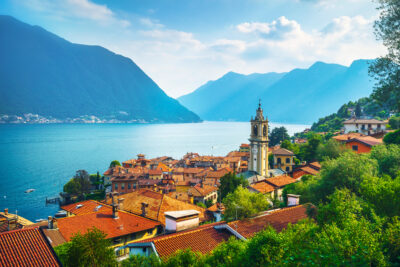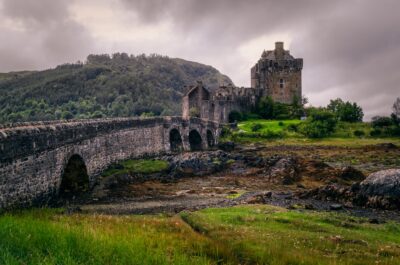Cathedrals and monasteries are powerful symbols of faith. From their historic grandeur to modern marvels, these sacred places are potent expressions of spirituality that play an essential role in community life. Cathedrals serve as seats of dioceses and are integral to the life of the church, while monasteries have historically been centers of learning, culture, and refuge.
Their architecture reflects the values and aesthetic of their respective epochs – Viking raids, Norman reorganizations, the Reformation, and various revival styles are evident throughout these structures. Both cathedrals and monasteries offer a glimpse into the past, showcasing how faith has shaped our culture, art, and society.
The main difference between cathedrals, monasteries, and churches lies in their role and hierarchy within the Christian community.
- CATHEDRALS – A cathedral is a specific type of church that serves as the central church of a diocese and is home to the bishop’s “cathedra” (throne), symbolizing his authority. It’s often larger and more architecturally elaborate.
- MONASTERIES – On the other hand, a monastery is a community of monks or nuns dedicated to religious life, often in a secluded setting, focusing on prayer, study, and work.
- CHURCHES – A church, meanwhile, is a general place of worship where Christian congregations gather, without the administrative significance of a cathedral or the communal focus of a monastery. Essentially, all cathedrals and monasteries can contain churches, but not all churches are cathedrals or monasteries.
Get more information on The World’s 10 Most Beautiful Cathedrals.
Notable Monasteries and Cathedrals from Around the World
-
 The Abbey of Sant’Antimo, Tuscany, Italy (12th century)
The Abbey of Sant’Antimo, Tuscany, Italy (12th century)- Visit Val d’Orcia in Tuscany and witness this 12th-century abbey for an unforgettable experience. The Abbey of Sant’Antimo is a masterpiece of Romanesque architecture, showcasing a combination of Lombard, French, and classical influences. Its tranquil silence is only broken during mass, when monks sing beautiful Gregorian chants, evoking a serene spiritual atmosphere.
- The abbey’s basilica ground plan reflects both its local heritage and foreign influences, making it a fascinating study of medieval architecture. According to legend, the abbey dates back to Charlemagne himself, who stopped here with his army. When his soldiers were afflicted by pestilence, an angel appeared to Charlemagne, instructing him to use local herbs as a remedy.
- In the 11th century, the abbey was an influential monastic foundation, controlling 38 churches from Pisa to Grosseto and owning over 1000 mansi (farm estates). Fragments from its initial construction remain in its crypt. The abbey’s entrance portal and the interior columns decorated with intricately carved capitals are outstanding examples of classical Romanesque styles, showcasing mythical beasts, leaves, and Biblical scenes. It’s a must-visit for those seeking peace, history, and stunning surroundings.
-
The Convent of Christ, Tomar, Portugal (12th century)
- Located in Tomar, this UNESCO World Heritage site tells the incredible story of the Knights Templar in Portugal. Built in the 12th century, the Convent of Christ was originally a stronghold for the Templars and later became a spiritual center of the Order of Christ after the Templars were disbanded. Its connection to both military and spiritual endeavors makes it an important monument of Portuguese history.
- The convent features multiple architectural styles, including Romanesque, Gothic, Manueline, Renaissance, and Mannerist, which makes it an architectural treasure. The Manueline-style church is particularly noteworthy, with its intricate ribbed vaulting and exquisitely decorated rotunda. The church’s rotunda, inspired by the Church of the Holy Sepulchre in Jerusalem, has an octagonal design adorned with murals, sculptures, and ornamental details reflecting Templar symbolism.
-
Rakotzbrücke (Devil’s Bridge), Kromlau, Germany (1860)
- Built in 1860, Rakotzbrücke is a stunning bridge (not a cathedral, church or monastery) located in Kromlau’s Rhododendron Park, an expansive 200-acre landscaped garden. This remarkable bridge is also known as the Devil’s Bridge due to the folklore surrounding its construction. The bridge was designed to create a perfect circle when reflected in the water below, an optical illusion that leaves visitors in awe. It is a testament to the creativity and ambition of 19th-century landscape architects.
- The story goes that the bridge was so extraordinary that it could only have been built with the devil’s help, and in return, the devil would claim the soul of the first person to cross it. Many “Devil’s Bridges” across Europe have similar myths, often associated with seemingly impossible feats of engineering. Rakotzbrücke’s striking silhouette has gained it international attention from Instagrammers and photographers, leading to an increase in visitors eager to see its surreal, almost magical reflection.
-
Heimaey Stave Church, Westman Islands, Iceland (2000)
- Heimaey Stave Church on Iceland’s Westman Islands is a striking black wooden church gifted by Norway to Iceland in 2000 to mark the 1,000-year anniversary of Christianity in Iceland. Modeled after the traditional stave churches of Norway, this church is a beautiful example of Nordic craftsmanship and heritage, featuring intricate carvings and traditional wooden construction techniques.
- The church’s location on Heimaey, the largest of the Westman Islands, adds to its allure. Heimaey is known for its volcanic landscapes, puffin colonies, and dramatic sea cliffs. The church’s dark wooden facade stands in stark contrast to the surrounding green hills and volcanic rocks, creating a visually striking scene. The interior is simple yet elegant, with hand-carved wood and a peaceful atmosphere.
- The Heimaey Stave Church is occasionally used for mass and weddings, and its picturesque setting makes it a popular choice for those looking for a unique and intimate venue. The story behind the church’s construction is also fascinating: it’s said that sailors who were lost at sea made a promise to build a church if they ever returned safely.
-
St. Basil’s Cathedral, Moscow, Russia (1561)
- Built by Ivan the Terrible between 1555 and 1561 to commemorate the capture of Kazan and Astrakhan, St. Basil’s Cathedral is one of Russia’s most iconic landmarks. It’s famous for its colorful onion domes, which symbolize the Heavenly City, and its labyrinthine interior filled with winding staircases and small chapels.
- Legend has it that Ivan the Terrible was so impressed with the beauty of the cathedral that he had the architect, Postnik Yakovlev, blinded so that he could never create anything more magnificent. The cathedral was secularized in 1929 and is now a museum, offering visitors the opportunity to explore its many chapels, each with its own distinct design and theme.
- St. Basil’s is part of the Red Square UNESCO World Heritage site and remains one of Moscow’s most visited attractions. Its vibrant colors and intricate patterns make it instantly recognizable, and its history reflects the rich and often turbulent past of Russia.
-

Sagrada Familia – Catholic church in Barcelona Sagrada Familia, Barcelona, Spain (Construction began in 1882)
- Designed by Antoni Gaudí, the Sagrada Familia is one of the most unique and magnificent cathedrals in the world. Construction began in 1882, and it is still a work in progress today. Gaudí devoted much of his life to the project, combining Gothic and Art Nouveau styles with natural forms that mimic the structure of trees, plants, and bones.
- The interior of the Sagrada Familia is equally breathtaking, with columns designed to resemble trees branching out to support the ceiling, creating the feeling of being inside a grand, sacred forest. The stained-glass windows fill the space with a kaleidoscope of colors, creating a sense of awe and wonder. Gaudí’s intention was for the Sagrada Familia to be “a temple of harmonious light.”
- Once completed, the Sagrada Familia will be the tallest church building in the world. Visiting the Sagrada Familia offers a glimpse into Gaudí’s visionary mind and his ability to blend faith, nature, and architecture. It is a UNESCO World Heritage site and a testament to the enduring spirit of creativity and dedication.
-
Notre-Dame Cathedral, Paris, France (1163)
- Construction of Notre-Dame began in 1163 under the reign of King Louis VII and took almost 200 years to complete. It stands as one of the finest examples of French Gothic architecture, with its impressive flying buttresses, large rose windows, and twin towers. The cathedral has witnessed significant historical events, such as the coronation of Napoleon Bonaparte and the beatification of Joan of Arc.
- Tragically, in April 2019, Notre-Dame suffered a devastating fire that destroyed its spire and much of the roof. However, the resilience of the structure and the determination to rebuild it have made it a symbol of hope for people around the world. Restoration efforts are currently underway, and the cathedral is expected to be fully restored in the coming years.
- The famous gargoyles and chimera that adorn Notre-Dame, as well as its stunning stained-glass windows, are among its most notable features. The cathedral’s immense size and the beauty of its architecture have made it an enduring symbol of Paris. Visiting Notre-Dame is a powerful experience, offering a connection to centuries of faith, art, and the human spirit.
-
Mont Saint-Michel Abbey, Normandy, France (8th century)
- Mont Saint-Michel is a breathtaking medieval abbey located on a rocky tidal island in Normandy. Originally founded by Bishop Aubert in the 8th century, it became a major pilgrimage site. The abbey is dedicated to the Archangel Michael, who, according to legend, appeared to Aubert and instructed him to build the church on the island. Its unique location, surrounded by tidal waters, creates a dramatic and ever-changing landscape.
- The abbey’s architecture is a mix of Gothic and Romanesque styles, with towering spires, intricate cloisters, and narrow passageways that give visitors a sense of stepping back in time. The journey to the top of the abbey involves climbing a series of steep staircases, but the effort is rewarded with breathtaking views of the bay and the surrounding countryside.
- Mont Saint-Michel has been a symbol of resilience throughout history, withstanding sieges during the Hundred Years’ War and remaining unconquered. It was also used as a prison during the French Revolution. Today, Mont Saint-Michel is a UNESCO World Heritage site and one of France’s most iconic landmarks, attracting millions of visitors each year who come to admire its beauty and experience its mystical atmosphere.
-
St. Patrick’s Cathedral, New York City, USA (1878)
- St. Patrick’s Cathedral, completed in 1878, is the largest Gothic Revival Catholic cathedral in North America. Located on Fifth Avenue in the heart of Manhattan, it serves as a symbol of Catholicism amidst the skyscrapers of New York City.
- The interior of St. Patrick’s is equally impressive, with high vaulted ceilings, a grand altar, and numerous chapels dedicated to saints. The cathedral can hold up to 3,000 worshippers, and it continues to be an active place of worship and a vital part of New York’s religious and cultural life.
- The cathedral’s famous organ, with over 7,000 pipes, is used for concerts and special services, adding to the grandeur of the experience. St. Patrick’s Cathedral is a testament to the faith of the Irish immigrants who helped build it and remains an enduring symbol of hope and community in New York City.
-

London Westminster Abbey St Margaret Church in England Westminster Abbey, London, England (Construction began in 960 AD)
- Westminster Abbey is one of the most important religious buildings in the United Kingdom, with a history that dates back over a thousand years. Construction of the current Gothic structure began in 1245 under the direction of King Henry III, and the abbey has since played a central role in British history. It has hosted every British coronation since 1066, including the recent coronation of King Charles III.
- The abbey is also famous for its royal weddings, including that of Prince William and Catherine Middleton in 2011. Its architectural grandeur, with stunning ribbed vaults, towering arches, and intricate stained-glass windows, makes it a true masterpiece of Gothic design. The abbey’s layout includes several chapels, including the beautiful Lady Chapel, which is known for its fan-vaulted ceiling.
Why You Should Visit These Sacred Sites
Visiting cathedrals and monasteries is more than just admiring beautiful architecture. It is a journey through time—into the spiritual and cultural legacy of humanity. These buildings offer an understanding of the faith, artistry, and resilience that has shaped the human experience for centuries. Their grandeur, history, and symbolism stand as testaments to enduring hope and inspiration for countless generations. Each cathedral and monastery has its own unique beauty and narrative, inviting you to explore and find your own connection to the divine.
Whether you are captivated by history, architecture, or spirituality, these iconic monasteries and cathedrals offer an experience that is unforgettable and deeply moving. They remind us of our shared human heritage and the values that continue to bind communities together—faith, hope, and beauty.
You can visit all of these magnificent cathedrals and monasteries by traveling with us at Two Travel Gurus. Let us guide you on an unforgettable journey through these sacred places and experience the magic for yourself. To see all our trips and start planning your adventure, visit our homepage at Two Travel Gurus.





